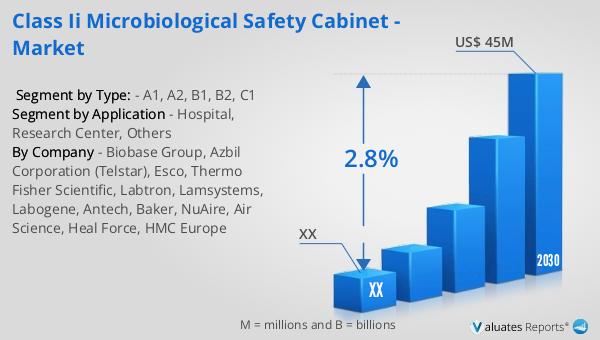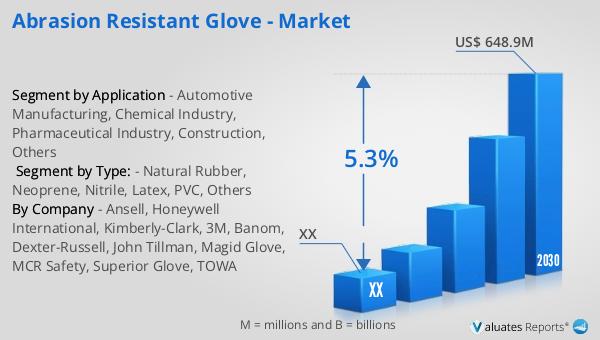What is Class II Microbiological Safety Cabinet - Global Market?
Class II Microbiological Safety Cabinets are essential tools in laboratories and healthcare settings worldwide. These cabinets are designed to provide a controlled environment that protects both the user and the samples from contamination. They work by filtering the air through high-efficiency particulate air (HEPA) filters, which remove harmful particles and microorganisms. This ensures that the air inside the cabinet is clean and safe for handling sensitive biological materials. The global market for these cabinets is driven by the increasing need for safety in laboratories, especially in fields like microbiology, pharmaceuticals, and biotechnology. As research and development activities continue to grow, so does the demand for reliable safety equipment. Additionally, stringent regulations regarding laboratory safety further propel the market. The cabinets are categorized into different classes based on their design and functionality, with Class II being the most commonly used due to its balance of protection for both the user and the environment. As the awareness of laboratory safety increases globally, the market for Class II Microbiological Safety Cabinets is expected to expand, reflecting the critical role these devices play in ensuring safe and efficient laboratory operations.

A1, A2, B1, B2, C1 in the Class II Microbiological Safety Cabinet - Global Market:
Class II Microbiological Safety Cabinets are further divided into several types, namely A1, A2, B1, B2, and C1, each with specific features and applications. Type A1 cabinets are designed to provide personnel and environmental protection but are not suitable for handling volatile chemicals or radionuclides. They recirculate a significant portion of the air within the cabinet, making them energy-efficient but limited in their scope of use. Type A2 cabinets, on the other hand, offer enhanced protection and are more versatile. They can handle small amounts of volatile chemicals and radionuclides, provided they are exhausted properly. This makes them suitable for a wider range of applications in laboratories that deal with hazardous materials. Type B1 cabinets are designed for handling low to moderate risk biological agents and small amounts of volatile chemicals. They have a dedicated exhaust system that ensures harmful vapors are safely removed from the work area. Type B2 cabinets provide the highest level of protection among Class II cabinets. They are completely exhausted, meaning no air is recirculated within the cabinet. This makes them ideal for handling hazardous chemicals and biological agents that require stringent containment measures. Finally, Type C1 cabinets are a newer addition to the Class II category. They offer flexibility in terms of airflow management, allowing users to switch between recirculating and exhausting air based on their specific needs. This adaptability makes them suitable for a variety of laboratory settings. Each type of Class II Microbiological Safety Cabinet is designed to meet specific safety requirements, ensuring that laboratories can operate safely and efficiently while minimizing the risk of contamination. The choice of cabinet depends on the specific needs of the laboratory, including the types of materials being handled and the level of protection required. As laboratory practices evolve and new challenges emerge, the demand for advanced safety cabinets continues to grow, driving innovation and development in this critical market segment.
Hospital, Research Center, Others in the Class II Microbiological Safety Cabinet - Global Market:
Class II Microbiological Safety Cabinets are widely used in hospitals, research centers, and other settings where biological safety is a priority. In hospitals, these cabinets play a crucial role in ensuring the safety of both healthcare workers and patients. They are used in laboratories for testing and analyzing patient samples, such as blood, tissue, and other bodily fluids. By providing a sterile environment, these cabinets help prevent the spread of infectious diseases and protect healthcare workers from exposure to harmful pathogens. In research centers, Class II Microbiological Safety Cabinets are indispensable tools for scientists working with biological materials. They provide a controlled environment that allows researchers to conduct experiments safely and accurately. This is particularly important in fields like microbiology, virology, and genetics, where contamination can compromise the integrity of experiments and lead to inaccurate results. The cabinets also protect researchers from exposure to potentially harmful substances, ensuring their safety while they work. Beyond hospitals and research centers, Class II Microbiological Safety Cabinets are used in a variety of other settings, including pharmaceutical companies, universities, and industrial laboratories. In pharmaceutical companies, they are used for drug development and quality control, ensuring that products are safe and effective before they reach the market. Universities use these cabinets for teaching and research purposes, providing students and faculty with a safe environment to conduct experiments and learn about biological processes. Industrial laboratories use them for quality assurance and testing, ensuring that products meet safety and regulatory standards. Overall, the versatility and reliability of Class II Microbiological Safety Cabinets make them an essential component of any facility that handles biological materials, helping to ensure safety and compliance with industry standards.
Class II Microbiological Safety Cabinet - Global Market Outlook:
The global market for Class II Microbiological Safety Cabinets was valued at approximately $37 million in 2023. It is projected to grow to a revised size of $45 million by 2030, with a compound annual growth rate (CAGR) of 2.8% during the forecast period from 2024 to 2030. This growth reflects the increasing demand for safety equipment in laboratories and healthcare settings worldwide. In North America, the market for these cabinets was valued at a certain amount in 2023 and is expected to reach a higher value by 2030, with a specific CAGR during the forecast period. This growth is driven by the region's strong focus on research and development, as well as stringent safety regulations that require the use of reliable safety equipment. The market outlook highlights the importance of Class II Microbiological Safety Cabinets in ensuring the safety and efficiency of laboratory operations. As the global demand for these cabinets continues to rise, manufacturers are focusing on developing innovative solutions that meet the evolving needs of laboratories and healthcare facilities. This includes advancements in technology, design, and functionality, which enhance the performance and usability of these critical safety devices. Overall, the market outlook for Class II Microbiological Safety Cabinets is positive, reflecting the essential role they play in maintaining safety and compliance in various industries.
| Report Metric | Details |
| Report Name | Class II Microbiological Safety Cabinet - Market |
| Forecasted market size in 2030 | US$ 45 million |
| CAGR | 2.8% |
| Forecasted years | 2024 - 2030 |
| Segment by Type: |
|
| Segment by Application |
|
| By Region |
|
| By Company | Biobase Group, Azbil Corporation (Telstar), Esco, Thermo Fisher Scientific, Labtron, Lamsystems, Labogene, Antech, Baker, NuAire, Air Science, Heal Force, HMC Europe |
| Forecast units | USD million in value |
| Report coverage | Revenue and volume forecast, company share, competitive landscape, growth factors and trends |
